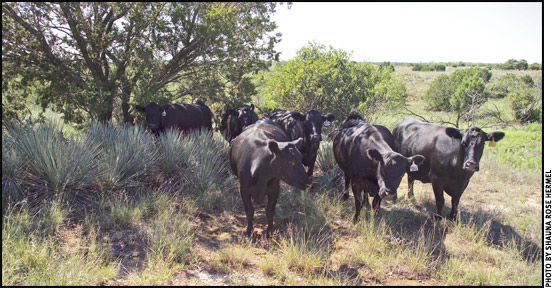
Researchers Find Clues to
Explain Effects of Heat Stress
"Biology of heat stress" could lead to new strategies for managing heat stress in livestock.
News headlines for the summer of 2011 tell a dismal story:
"Heat hits farmers…"
"USDA lowers milk production forecast …"
"Bleak message to cattle producers …"
Record heat waves hit across the United States, leaving animal producers wondering how to deal with heat stress in their herds. Heat stress can kill animals, but even non-life-threatening temperatures can be devastating. Animals eat less and produce less milk or meat. Agricultural production suffers, and the world is left with less food.
"It's a billion-dollar issue in the American dairy industry alone," said Lance Baumgard, the Norman Jacobson Endowed Professor of Nutritional Physiology at Iowa State University. "It's a food security issue in many developing countries."
Baumgard has been working with Virginia Tech animal scientist Robert Rhoads to learn more about how heat stress affects animals. Baumgard and Rhoads have found that loss of appetite due to heat stress is not the only reason animals become less productive. A rise in insulin levels and changes in energy metabolism are also important. Baumgard will present a review of their research at a preconference symposium of the Joint Annual meeting of the American Society of Nutrition (ASN), American Dairy Science Association (ADSA) and the American Society of Animal Science (ASAS) in Phoenix, Ariz., July 15, 2012.
In an interview with ASAS, Baumgard said his research into the "biology of heat stress" could lead to new strategies for managing heat stress in livestock.
Baumgard and Rhoads have used lactating and growing Holsteins, pigs and rodents to study how heat stress changes the way animals use energy. Baumgard said their studies challenge the "dogma" that animals become less productive simply because they eat less when heat-stressed. Baumgard said it is true that animals eat less; however, "Animals produce much less than what the reduction in feed intake would suggest."
Why does production decrease more than it should? One explanation may be related to insulin levels.
In normal circumstances, insulin levels respond to glucose levels in the blood. To maintain homeostasis, insulin stimulates blood glucose uptake by body tissue (for energy or storage). If an animal eats less, insulin levels decrease because there is less glucose in the blood. But Baumgard and Rhoads have found that insulin levels actually increase dramatically in heat-stressed animals despite the fact that heat-stressed animals consume less feed.
"This is very strange," said Baumgard.
The increased insulin levels change how animals use energy and partition nutrients. Cattle, like humans, store excess energy in fat cells. When heat-stressed cattle start eating less, one would expect them to use that stored-up energy to make up for the lack of dietary calories. However, the increased insulin blocks the hormonal signals that should lead to fat breakdown.
The animals have the energy, but they are not using it.
The increased insulin also changes how the animal uses feed energy when heat-stressed. Instead of relying on energy from fatty acids in the diet, heat-stressed animals rely more on energy from glucose.
"That's an inefficient system," said Baumgard.
Baumgard are Rhoads still are not sure why insulin levels change so dramatically during periods of heat stress, but this research does partially explain the gap between how much production is predicted to decline and how much production actually declines.
This research could help more than just farm animals. Baumgard said their studies with rodents and pigs have shown "amazing" similarities to the cattle studies. He thinks it would be interesting to expand these studies to look at heat stress in humans.
"Human soldiers and athletes are particularly susceptible to heat stress," Baumgard said.
Editor's Note: This article is provided by the American Society of Animal Science via its April 2012 Taking Stock newsletter, which may be found online at www.asas.org/takingstock/.
[Click here to go to the top of the page.]









